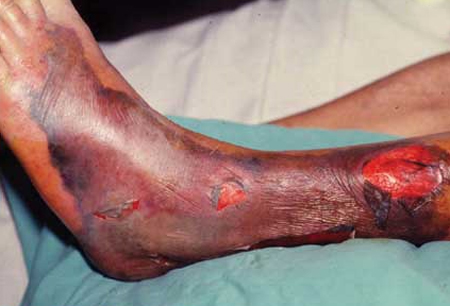Resumo
Definição
História e exame físico
Principais fatores diagnósticos
- presença de fatores de risco
- dor nas pernas
- celulite
- diarreia
- cólicas abdominais
- dor de ouvido
- dor ocular, vermelhidão
Outros fatores diagnósticos
- febre
- estado mental alterado
- náuseas
- vômitos
- hipotensão
Fatores de risco
- exposição a águas salobras ou marinhas
- manuseio e/ou limpeza de frutos do mar
- ingestão de frutos do mar crus ou malcozidos
- doença hepática subjacente (cirrose, hepatite B ou C, hemocromatose)
- na vigência de uso de corticosteroide ou outra imunossupressão (vírus da imunodeficiência humana [HIV], quimioterapia, transplante de órgão sólido)
Investigações diagnósticas
Primeiras investigações a serem solicitadas
- hemograma completo
- contagem plaquetária
- perfil metabólico básico
- lactato sanguíneo
- hemocultura
- swab da ferida para coloração de Gram
- swab da ferida para cultura
- coprocultura
- swab do meato acústico externo para cultura
- swab conjuntival, raspagem córnea ou aspirados da câmera para cultura
- exame diagnóstico independente de cultura (CIDT)
Algoritmo de tratamento
sepse ou infecção sistêmica grave
infecção cutânea/de tecidos moles localizada isolada
gastroenterite
infecções superficiais por inoculação
Colaboradores
Autores
Michael Sands, MD, MPH & TM, FIDSA

Professor of Medicine
College of Medicine
University of Florida
Jacksonville
FL
Declarações
MS declares that he has no competing interests.
Carmen Isache, MD

Associate Professor of Medicine
College of Medicine
University of Florida
Jacksonville
FL
Declarações
CI declares that she has no competing interests.
Revisores
Larry Bush, MD, FACP, FIDSA
Affiliated Professor of Medicine
Charles E. Schmidt College of Medicine
Florida Atlantic University
Affiliated Associate Professor of Medicine
Department of Medical Education
University of Miami-Miller School of Medicine
FL
Declarações
LB declares that he has no competing interests.
Franz Allerberger, MD, MPH
Professor of Clinical Microbiology
Austrian Agency for Health and Food Safety (AGES)
Vienna
Austria
Declarações
FA declares that he has no competing interests.
Créditos aos pareceristas
Os tópicos do BMJ Best Practice são constantemente atualizados, seguindo os desenvolvimentos das evidências e das diretrizes. Os pareceristas aqui listados revisaram o conteúdo pelo menos uma vez durante a história do tópico.
Declarações
As afiliações e declarações dos pareceristas referem--se ao momento da revisão.
Referências
Principais artigos
Dechet AM, Yu PA, Koram N, et al. Nonfoodborne Vibrio infections: an important cause of morbidity and mortality in the United States, 1997-2006. Clin Infect Dis. 2008;46:970-6. Resumo
California Department of Public Health. CDPH IDB guidance for managing select communicable diseases: non-cholera Vibrio infections. Jun 2023 [internet publication].Texto completo
Evans L, Rhodes A, Alhazzani W, et al. Surviving Sepsis Campaign: international guidelines for management of sepsis and septic shock 2021. Crit Care Med. 2021 Nov 1;49(11):e1063-143.Texto completo Resumo
Centers for Disease Control and Prevention. Vibrio species causing vibriosis. Information for health professionals and laboratorians. Aug 2023 [internet publication].Texto completo
Artigos de referência
Uma lista completa das fontes referenciadas neste tópico está disponível para os usuários com acesso total ao BMJ Best Practice.

Diagnósticos diferenciais
- Sepse
- Gangrena
- Diarreia infecciosa
Mais Diagnósticos diferenciaisDiretrizes
- Non-cholera Vibrio infections
- Vibrio species causing vibriosis: information for health professionals & laboratorians
Mais DiretrizesFolhetos informativos para os pacientes
Úlceras da perna
Diarreia em crianças
Mais Folhetos informativos para os pacientesConectar-se ou assinar para acessar todo o BMJ Best Practice
O uso deste conteúdo está sujeito ao nosso aviso legal